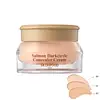What's inside
What's inside
 Key Ingredients
Key Ingredients

 Benefits
Benefits

 Concerns
Concerns

 Ingredients Side-by-side
Ingredients Side-by-side

Petrolatum
EmollientLanolin Oil
EmollientCaprylic/Capric Triglyceride
MaskingAluminum Starch Octenylsuccinate
AbsorbentParaffin
PerfumingPolyethylene
AbrasiveSorbitan Sesquioleate
EmulsifyingGlyceryl Tribehenate/Isostearate/Eicosandioate
EmollientMicrocrystalline Wax
Emulsion StabilisingTocopheryl Acetate
AntioxidantAscorbyl Tetraisopalmitate
AntioxidantEthylhexylglycerin
Skin ConditioningSalmon Egg Extract
Water
Skin ConditioningGlycerin
HumectantSteareth-20
CleansingN-Hydroxysuccinimide
Skin ConditioningDiacetyl Boldine
Skin ConditioningPalmitoyl Tripeptide-1
Skin ConditioningChrysin
Skin ConditioningPalmitoyl Tetrapeptide-7
Skin ConditioningAlpha-Isomethyl Ionone
PerfumingLinalool
PerfumingButylphenyl Methylpropional
PerfumingPetrolatum, Lanolin Oil, Caprylic/Capric Triglyceride, Aluminum Starch Octenylsuccinate, Paraffin, Polyethylene, Sorbitan Sesquioleate, Glyceryl Tribehenate/Isostearate/Eicosandioate, Microcrystalline Wax, Tocopheryl Acetate, Ascorbyl Tetraisopalmitate, Ethylhexylglycerin, Salmon Egg Extract, Water, Glycerin, Steareth-20, N-Hydroxysuccinimide, Diacetyl Boldine, Palmitoyl Tripeptide-1, Chrysin, Palmitoyl Tetrapeptide-7, Alpha-Isomethyl Ionone, Linalool, Butylphenyl Methylpropional
Water
Skin ConditioningC15-19 Alkane
SolventButylene Glycol
HumectantCoco-Caprylate
EmollientPolyglyceryl-3 Polyricinoleate
EmulsifyingBetaine
HumectantOryza Sativa Bran Oil
EmollientVegetable Oil
Skin ConditioningMagnesium Stearate
Cosmetic ColorantPropanediol
SolventGlycerin
HumectantHelianthus Annuus Seed Wax
Skin ConditioningOryza Sativa Bran Wax
Skin ConditioningRhus Succedanea Fruit Wax
Polyglyceryl-3 Diisostearate
EmulsifyingSodium Chloride
MaskingCrataegus Monogyna Flower Extract
Skin ConditioningJasminum Sambac Flower Extract
MaskingPhenoxyethanol
PreservativeAluminum Hydroxide
EmollientPolyglyceryl-4 Caprate
EmulsifyingSodium Lauroyl Glutamate
Ethylhexylglycerin
Skin ConditioningLysine
Skin ConditioningMagnesium Chloride
Citric Acid
BufferingAscorbyl Palmitate
AntioxidantTocopherol
AntioxidantCI 77891
Cosmetic ColorantCI 77491
Cosmetic ColorantCI 77492
Cosmetic ColorantCI 77499
Cosmetic ColorantWater, C15-19 Alkane, Butylene Glycol, Coco-Caprylate, Polyglyceryl-3 Polyricinoleate, Betaine, Oryza Sativa Bran Oil, Vegetable Oil, Magnesium Stearate, Propanediol, Glycerin, Helianthus Annuus Seed Wax, Oryza Sativa Bran Wax, Rhus Succedanea Fruit Wax, Polyglyceryl-3 Diisostearate, Sodium Chloride, Crataegus Monogyna Flower Extract, Jasminum Sambac Flower Extract, Phenoxyethanol, Aluminum Hydroxide, Polyglyceryl-4 Caprate, Sodium Lauroyl Glutamate, Ethylhexylglycerin, Lysine, Magnesium Chloride, Citric Acid, Ascorbyl Palmitate, Tocopherol, CI 77891, CI 77491, CI 77492, CI 77499
 Reviews
Reviews

Alternatives
Ingredients Explained
These ingredients are found in both products.
Ingredients higher up in an ingredient list are typically present in a larger amount.
Ethylhexylglycerin (we can't pronounce this either) is commonly used as a preservative and skin softener. It is derived from glyceryl.
You might see Ethylhexylglycerin often paired with other preservatives such as phenoxyethanol. Ethylhexylglycerin has been found to increase the effectiveness of these other preservatives.
Glycerin is already naturally found in your skin. It helps moisturize and protect your skin.
A study from 2016 found glycerin to be more effective as a humectant than AHAs and hyaluronic acid.
As a humectant, it helps the skin stay hydrated by pulling moisture to your skin. The low molecular weight of glycerin allows it to pull moisture into the deeper layers of your skin.
Hydrated skin improves your skin barrier; Your skin barrier helps protect against irritants and bacteria.
Glycerin has also been found to have antimicrobial and antiviral properties. Due to these properties, glycerin is often used in wound and burn treatments.
In cosmetics, glycerin is usually derived from plants such as soybean or palm. However, it can also be sourced from animals, such as tallow or animal fat.
This ingredient is organic, colorless, odorless, and non-toxic.
Glycerin is the name for this ingredient in American English. British English uses Glycerol/Glycerine.
Learn more about GlycerinWater. It's the most common cosmetic ingredient of all. You'll usually see it at the top of ingredient lists, meaning that it makes up the largest part of the product.
So why is it so popular? Water most often acts as a solvent - this means that it helps dissolve other ingredients into the formulation.
You'll also recognize water as that liquid we all need to stay alive. If you see this, drink a glass of water. Stay hydrated!
Learn more about Water